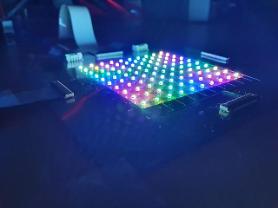
[Courtesy of LG Display]
"We are conducting a study on RGB OLED. We are in the stage of technology development in the 30-inch range," LG Display's life display division head Lee Hyun-woo, told a seminar in the southern port city of Busan on April 7.
By configuring the intensity of each OLED, manufacturers produce other colors. To produce purely blue light, the blue OLED is set to the highest intensity. For white light, all three LEDs are set to the highest intensity. To produce other colors, three colors are combined in different intensities.
For ordinary OLED panels, white light sources pass through RGB color filters. Fine metal masks deposit red, green and blue emission layers. The deposition is the process of heating an organic material in a vacuum. LG Display uses an open metal mask for large panels that stack RGB organic materials vertically with three colors mixed to produce a white light source.
A WOLED (White OLED) panel emits white light. An RGB OLED display does not use filters and each pixel consists of three sub-pixels that themselves radiate their main color. Lee said that WOLED and RGB OLED have high-efficiency areas, respectively.
Lee said that an OLED.EX panel unveiled in December 2021 expresses natural colors as it is. The product improved screen brightness by 30 percent by applying heavy hydrogen and personalization algorithms. The company changed hydrogen elements into deuterium with a more stable structure to express realistic and three-dimensional details of particles and accurately convey the original color.
"When we analyzed the color of videos usually watched by customers, 70 percent of them were in high brightness areas close to white," Lee said. "Improving image quality in color areas near the white is more important and effective in implementing realistic images."
The OLED.EX panel is equipped with a technology that maximizes the difference between bright and dark parts, Lee said. Although OLED.EX increased brightness, it minimized blue light that is harmful to eyes. "It's eco-friendly because it doesn't use backlight and it reduces parts," he said. LG Display would use OLED.EX for gaming, transparent and portable panels.
LG Display has developed bendable, foldable and rollable OLED panels. The company is now involved in a project to develop stretchable displays which are seen as the final phase of flexible display technologies. The world's first rollable TV unveiled at an electronics show in the United States in January 2019 can completely roll down its display into a box-shaped body when it is not being used. It can also roll out completely or partially to match the type of video content that is being played.
Copyright ⓒ Aju Press All rights reserved.



![[CES 2022] Samsung unveils quantum dot OLED panels, shows confidence in competition](https://image.ajunews.com/content/image/2022/01/05/20220105140014424172_278_163.jpg)